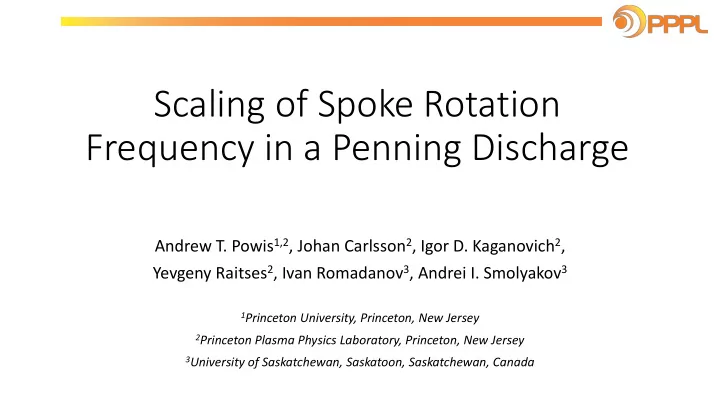

Scaling of Spoke Rotation Frequency in a Penning Discharge Andrew T. Powis 1,2 , Johan Carlsson 2 , Igor D. Kaganovich 2 , Yevgeny Raitses 2 , Ivan Romadanov 3 , Andrei I. Smolyakov 3 1 Princeton University, Princeton, New Jersey 2 Princeton Plasma Physics Laboratory, Princeton, New Jersey 3 University of Saskatchewan, Saskatoon, Saskatchewan, Canada
Rotating Spoke in the Penning Discharge • The Penning discharge is a R-Z cross section of the Penning discharge experiment simplified device for studying E x B phenomenon • Improved access for diagnostics • Quasi-two-dimensional geometry for simpler theoretical and computational analysis • Our simulations model the Penning discharge in the PPPL Y. Raitses et al , IEPC-2015-307 (2015) HTX laboratory
Code Development • Modifications to commercial PIC-MCC code LSP* R- θ cross section of the Penning discharge simulation domain to enable production run large-size long-time kinetic simulations • Improved collision models • Integration with PETSc for faster Poisson solve • Scaling of relative permittivity to increase cell size • Penning discharge is modeled in 2D-3V • 250 x 250 Cartesian grid with stair-stepping circular conducting boundary • Electrons are injected in the center • Helium ions are either injected or form via ionization • Δ x = 200 μ m and Δ t = 40 ps • 2 days to simulate 200 μ s (5e6 steps) on 28 cores 5 cm *T. P. Hughes, et al , Phys. Rev. Spec. Top.-Accel. Beams 2 , 100401 (1999)
The Spoke Forms With & Without Ionization Electron density contours, for spoke forming without ionization. Frequency 66.0 kHz Electron density contours, for spoke forming with ionization. Frequency 62.4 kHz A.T. Powis et al , Physics of Plasmas 25 , 072110 (2018)
Spoke Frequency Scaling Motivated by Linear Theory for the Collisionless Simon-Hoh Instability E r - Time averaged radial electric field 1 𝑓𝐹 𝑠 𝑀 𝑜 L n - Time averaged gradient length 𝑔 𝑡,𝑢ℎ = scale 𝜌𝑆 0 𝑛 𝑗 R 0 – Penning discharge radius Measured spoke frequency f s (blue) and theoretical frequency f s,th (green) against discharge current I d (left), applied field strength B (middle) and inverse square-root of mass ratio (right) A.I. Smolyakov et al , Plasma Phys. Control Fusion 59 , 014041 (2017)
Anomalous Transport through the Spoke Plot of instantaneous electron density (blue) and Radial cross-field electron radial electron current (red) against time transport is enhanced within the spoke structure Density and current probe location A.T. Powis et al , Physics of Plasmas 25 , 072110 (2018)
Open Questions • What is the fundamental mechanism for the formation of the spoke? • Is it the saturation of one single type of mode? • Is it the interaction of many modes (inverse cascade)? • What role does ionization play in higher pressure discharges (such as a HiPIMS magnetron)? • Why does the simple collisionless Simon-Hoh linear theory do a good job of describing the spoke frequency scaling? • What role does the spoke play in anomalous transport? • Which wavenumbers are responsible for enhancing transport?
Backup
Collisionless Simon Hoh Instability • Driven by charge separation between ions and electrons due to different rates of 𝐹 × 𝐶 and diamagnetic drifts. • Ions are weakly magnetized, therefore electrons drift faster. • If 𝑭 0 ⋅ ∇𝑜 0 > 0 the resulting charge separation will enhance the density perturbation.
Collisionless Simon Hoh Instability 𝜕 = 𝜕 0𝑗 + 𝑙 2 𝑑 𝑡 2 4 2 𝑙 4 𝑑 𝑡 2 + 𝑙 2 𝑑 𝑡 + 𝜕 0𝑗 − 𝜕 0 2𝜕 ∗ 4𝜕 ∗ 𝜕 ∗ • From measures values of diamagnetic velocity, ExB velocity and ion sound speed and assuming no ion rotation 𝜕 0𝑗 = 0 we obtain, 2 𝑤 0 𝑤 𝑡 𝑓𝐹 𝑠 𝑀 𝑜 𝑙 2 = 𝑙 2 𝜕 ≈ 𝑤 ∗ 𝑛 𝑗 • Assume a single azimuthal mode propagating at 𝑠 = 𝑆 0 /2 leads to the assumed scaling of, 1 𝑓𝐹 𝑠 𝑀 𝑜 𝑔 𝑡,𝑢ℎ ≈ 𝜌𝑆 0 𝑛 𝑗
Averaged Spoke Radial Profiles
Recommend
More recommend